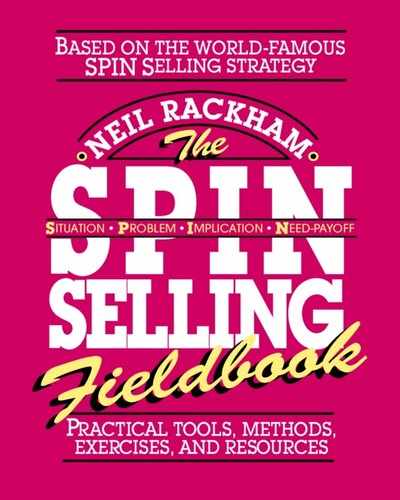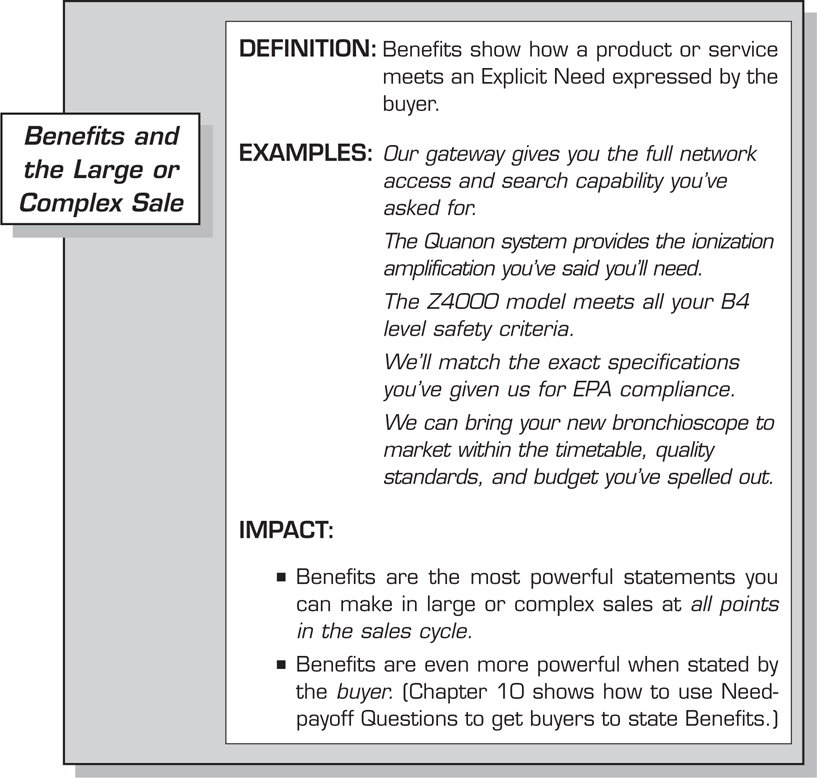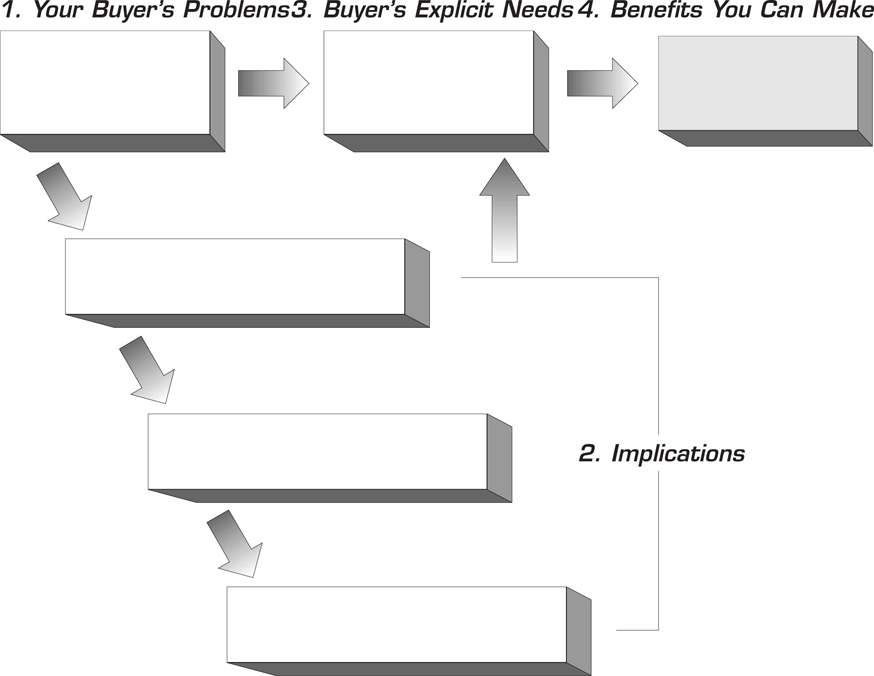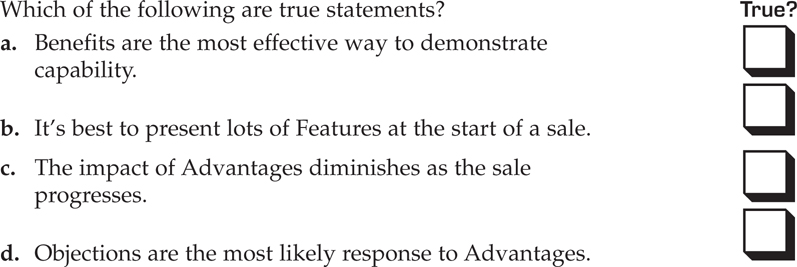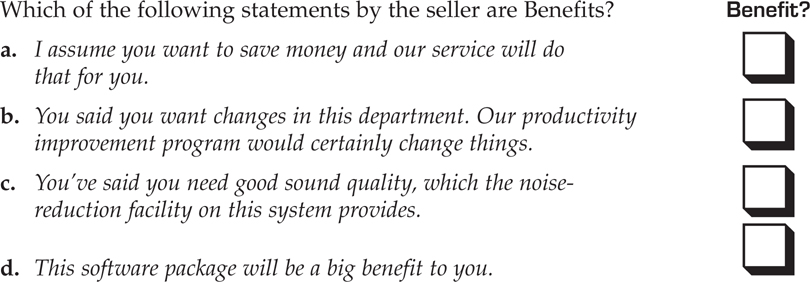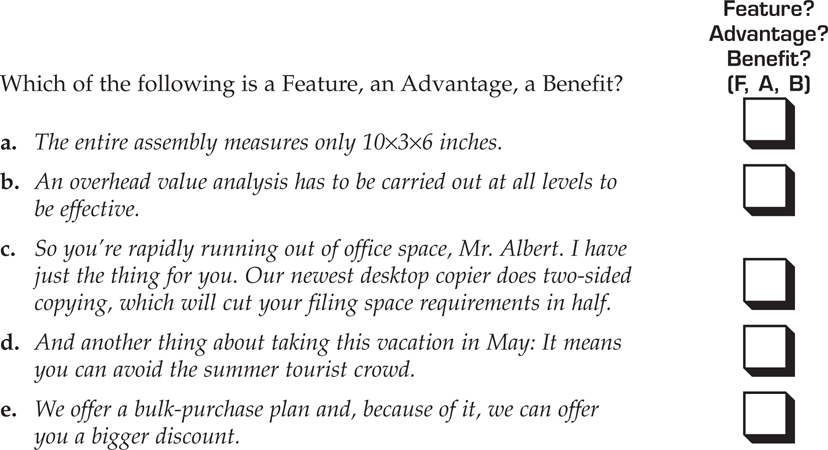11
Demonstrating Capability
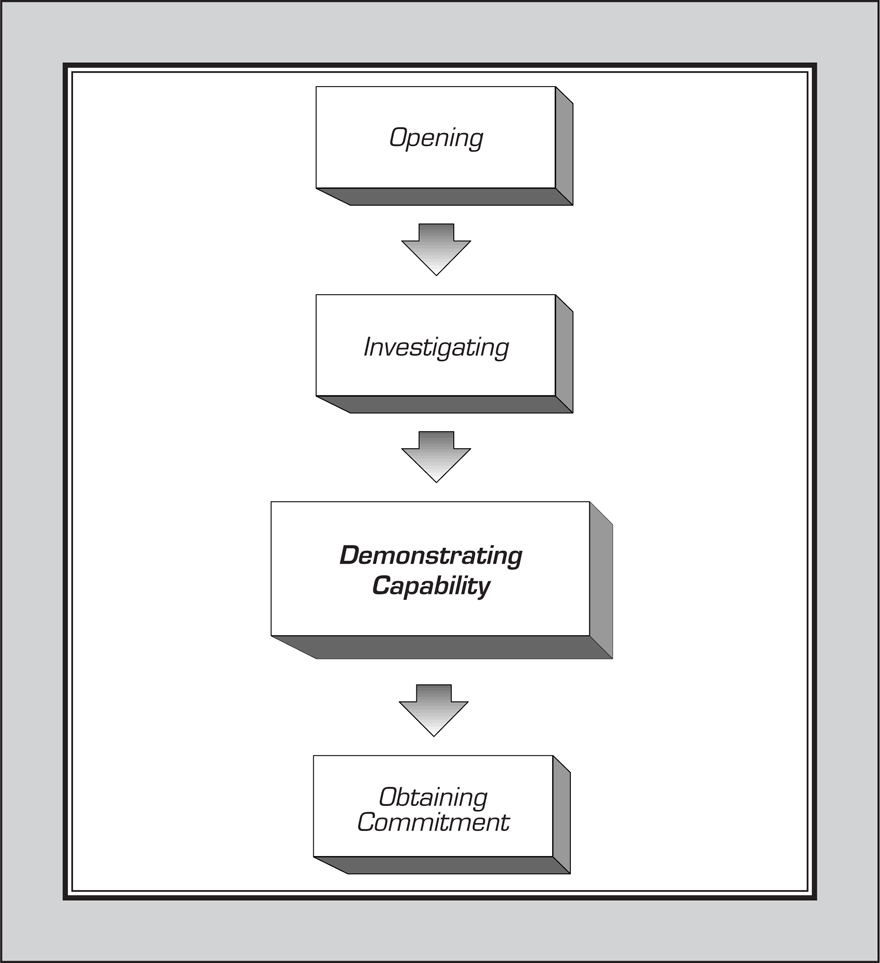
Overview
There are three ways to describe capabilities:
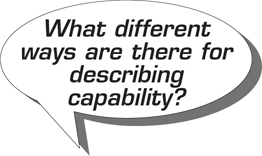
![]() Features—Describe facts or characteristics of a product or service, e.g., “We have forty skilled technicians …”
Features—Describe facts or characteristics of a product or service, e.g., “We have forty skilled technicians …”
![]() Advantages—Describe how a Feature can be used or can help the buyer, e.g., “Because of [that feature], you’d get quick response to a breakdown.”
Advantages—Describe how a Feature can be used or can help the buyer, e.g., “Because of [that feature], you’d get quick response to a breakdown.”
![]() Benefits—Describe how a Feature or Advantage meets an Explicit Need expressed by the buyer, e.g., “We can give you the one-hour response time you said you want.” Notice that we’re using a very specific definition of Benefits. You may be familiar with the term but not the special way we’re defining it here.
Benefits—Describe how a Feature or Advantage meets an Explicit Need expressed by the buyer, e.g., “We can give you the one-hour response time you said you want.” Notice that we’re using a very specific definition of Benefits. You may be familiar with the term but not the special way we’re defining it here.
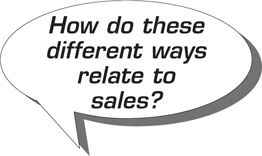
Research shows that Benefits, as defined here, are the most persuasive way to describe solutions, and are particularly powerful in large or complex sales.
In large or complex sales, the result of using each of these methods is quite different from using them in a simple sale. For large or complex sales, you first have to develop the buyer’s needs and build the value of your solution. Then, making Benefits will enable you to:
![]() Prevent objections, rather than having to “handle” objections.
Prevent objections, rather than having to “handle” objections.
![]() Help internal sponsors sell for you most effectively.
Help internal sponsors sell for you most effectively.
![]() Gain buyer support or approval for your solution.
Gain buyer support or approval for your solution.

To Demonstrate Capability effectively,
![]() You need to complete the Investigating stage before you introduce your solution.
You need to complete the Investigating stage before you introduce your solution.
![]() Your buyer has to express an Explicit Need (not just an Implied Need) you can meet.
Your buyer has to express an Explicit Need (not just an Implied Need) you can meet.
CHECK YOURSELF—DEMONSTRATING CAPABILITY
Before we go into more detail on Demonstrating Capability, check to see if you’re clear about the differences between Features, Advantages, and Benefits by answering the following questions. Watch out for the strict way we define Benefits, so that a statement is only a Benefit if it meets an Explicit Need that the buyer has expressed.
Feature,
Advantage,
or Benefit?
Answers are on the next page.
DEMONSTRATING CAPABILITY—ANSWERS
1. Advantage The statement shows how the Feature (a consolidated statement) can help the buyer. Since the buyer has not expressed a need to reconcile all accounts at the same time, this is not a Benefit.
2. Feature The statement provides facts about the course.
3. Advantage The statement describes how the Feature (UV protection) can help the buyer. It’s not a Benefit because no need has been expressed.
4. Feature The seller is describing a characteristic of the leasing system.
5. Advantage The statement describes how a Feature (remote command capability) is used.
6. Benefit The seller shows how the service can meet an Explicit Need (for quick response time) expressed by the buyer.
7. Advantage Since the buyer has not expressed a need to save money, it is not a Benefit. Even if the seller is sure that the buyer really needs to save money, it is only a Benefit if the buyer actually stated the need.
8. Advantage The seller is showing the buyer how the seller’s service could help the buyer, but the buyer hasn’t expressed a need for “a multifaceted approach.”
Note: Don’t worry if you found some of these examples difficult, especially the differences between Advantages and Benefits. Many people do, including experienced sellers. The good news is that the rest of this chapter will clarify and explain the importance of these distinctions.
Features, Advantages, and Benefits
Throughout this book, we’ve highlighted the importance of developing your buyer’s needs by asking Problem and Implication Questions before introducing your solution. We’ve also shown you how to use Need-payoff Questions to build the buyer’s desire for a solution. Now that you’re ready to actually demonstrate the capability of your solution, what’s the best way to do it?
The three classic ways of demonstrating capability are by using Features, Advantages, and Benefits. But each has quite different impacts—depending on whether the sale is large or small and where in the sales cycle they are introduced. In this chapter, we’ll focus on the effects of Features, Advantages, and Benefits in large or complex sales, and how to use each most effectively.
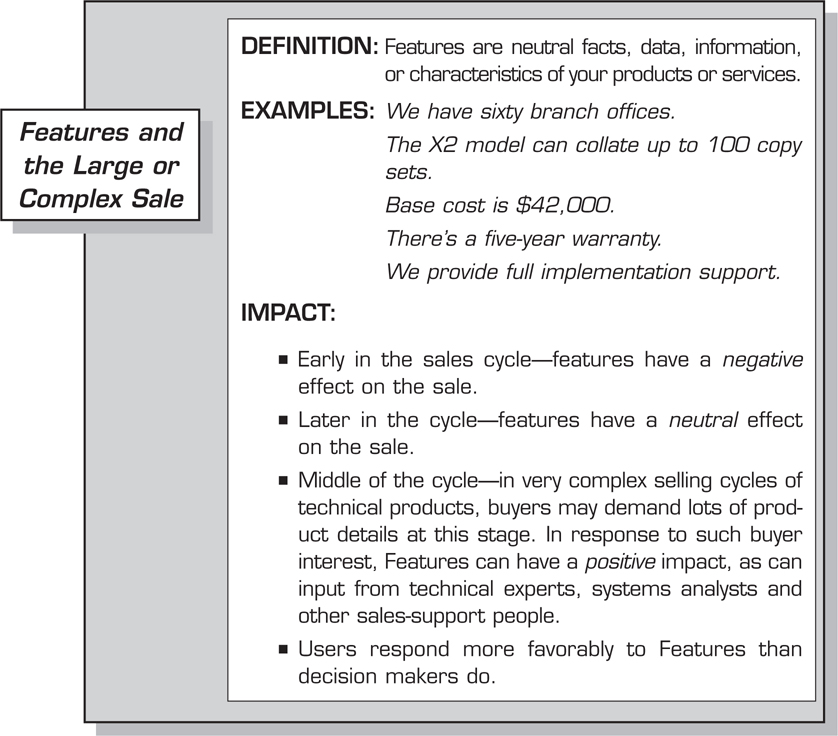
Advantages
Advantages are what most sales-oriented books and training programs mean when they talk about “benefits.” As SPIN® Selling explains, we first dubbed these “Type A Benefits” after testing a number of different definitions. During subsequent research in actual sales calls, we noticed that their effect on buyers is dramatically different from the effects of “Type B Benefits,” or what we’ve since called “Benefits.”

Defining Benefits
We’ve seen that Features are fairly easy to define. But what about Benefits? People often define “benefits” in different ways. We’ve said that most sales training focuses on Advantages rather than on Benefits. Some people say benefits must show a competitive superiority, others emphasize that benefits must show a cost saving, while still others insist that benefits have to include a personal element (“you appeal”) for the individual buyer, not just the buyer’s organization.
We chose the very strict definition that “a Benefit meets an Explicit Need expressed by the buyer” because research shows that this definition, out of six we tested, is the one most clearly related to success in large sales.
We won’t repeat here the process we went through to come to our conclusions, well described in SPIN® Selling. But it is essential to understand the distinctions between Advantages and Benefits as we define them, so that you can use Benefits to increase your impact on buyers.
True Benefits
Why do we insist that a statement can only be a Benefit if it meets an Explicit Need expressed by the buyer? Because if you make statements of this type, your calls are more likely to result in Orders or Advances. What makes these statements so much more powerful than other ways to describe your products or services? Two things:
1. By linking your offering to the buyer’s expressed needs, you demonstrate that you can help with the issues that matter most to your buyer. Before you can give a Benefit, your buyer must first express a need. Your products or services, as we’ve seen, meet needs. It’s not enough for you to assume that your buyer must have a need. By getting the buyer to express that need, you confirm its importance.
2. Based on the definitions we’ve explained here, average sellers tend to use Advantages, which address only Implied Needs, while the most successful use Benefits, which directly respond to Explicit Needs. The most successful salespeople first develop Implied Needs into Explicit Needs (clear wants or desires), using Implication and Need-payoff Questions. Then, once they have obtained Explicit Needs, they offer solutions showing how they can meet those wants or desires. Remember, average sellers offer solutions as soon as they have uncovered a problem—in other words, they offer solutions to Implied Needs.
How Features, Advantages, and Benefits Affect Buyers
Features, Advantages, and Benefits each have a different effect on a buyer. For example, if a Jupiter car salesperson in Vermont reels off an array of features such as engine characteristics, electronics, climate control functions, and cosmetic options, what immediately fills the prospective buyer’s mind? Yes, skyrocketing dollar signs:

In the buyer’s mind, each feature must add to the cost. So, by extension, the more Features recited by the seller, the higher the total price tag expected by the buyer.
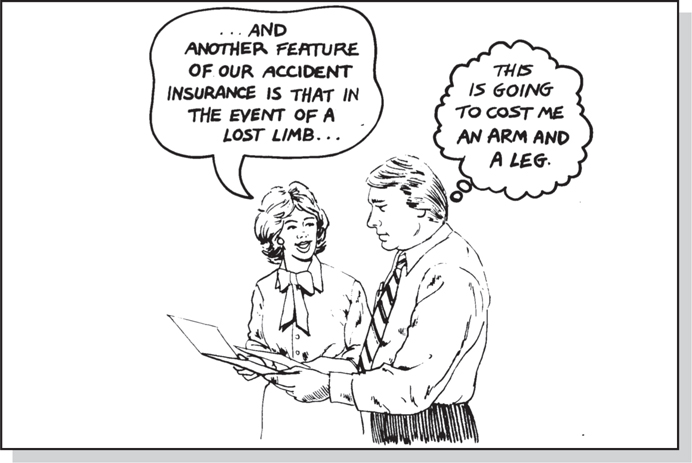
Next, the same car salesperson tells that buyer how helpful it will be to have the four-wheel drive model with a built-in ski rack during the winter, which will provide both safety and convenience. But not having asked about the buyer’s needs, how would the salesperson know that the buyer is planning to move to Florida in August? Will the buyer be impressed with the four-wheel drive option? Not on your life. S/he’s most likely to object (if not leave the showroom).
Why? Because the salesperson is offering a solution where no Explicit Need has been expressed. When the buyer doesn’t perceive a need for the capability being offered, the natural response is an objection.

In our final scene at the Jupiter showroom, the salesperson takes the time to ask Problem and Implication Questions. In doing so, the seller learns that the buyer makes long drives at night and suffers from eyestrain and lower back problems from the uncomfortable seat and driver position in the existing car.
Next, the salesperson asks Need-payoff questions, which build the value of finding a solution (a seat with lumbar support and extra bright headlights). As a result, the buyer expresses Explicit Needs—i.e., describing exactly what s/he’d want to include in a new car.
As the conversation continues, the salesperson identifies specific Benefits—showing how a new Jupiter with orthopedically designed seats will provide the lumbar support the buyer needs on long drives, while the high-intensity halogen headlights will prevent eyestrain. Because these are things the buyer wants, the seller doesn’t get objections. Giving Benefits, the research shows, is the most effective way to demonstrate capability. The result:

Preventing Objections vs. Handling Objections
Let’s look closer at the issue of Advantages leading buyers to respond with objections. We’ve seen that this occurs when the seller proposes a solution before building needs sufficiently. As a result, the buyer doesn’t feel the problem is serious or urgent enough to justify an expensive solution.
That brings us back to the value equation presented in Chapter 6. To obtain the buyer’s commitment to a sale, you need to build the value of the problems or needs enough to outweigh the cost of the solution. The value equation also shows that building the value of the buyer’s problems actually prevents objections. Preventing objections ultimately costs sellers less than handling objections—less time, energy, and hassle. (For detailed case studies, see SPIN® Selling, pages 124–135.)
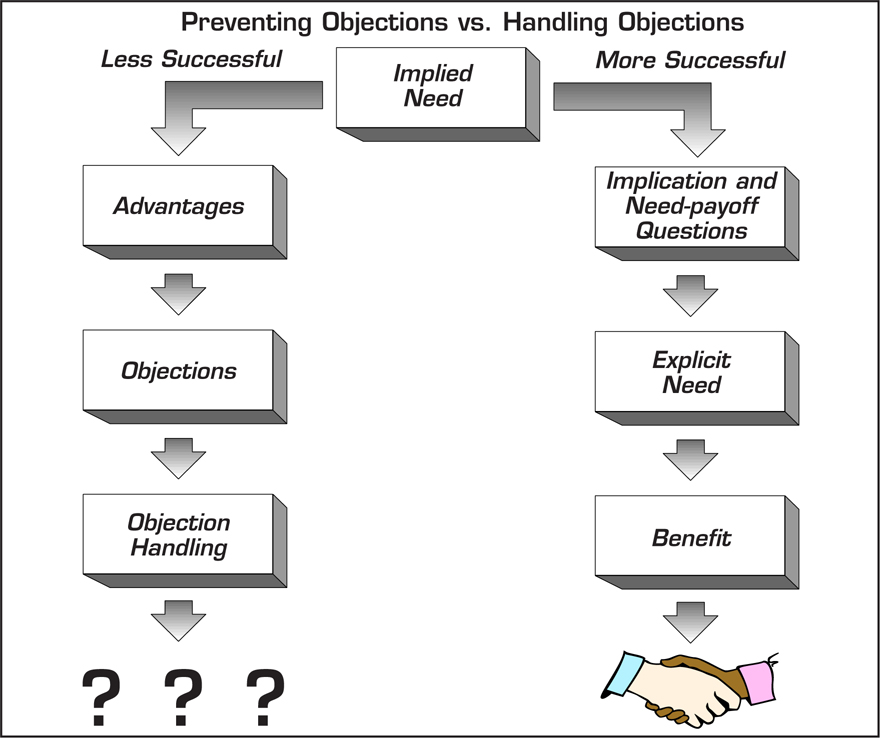
Handling Value Objections
Value objections emerge when the buyer raises doubts about the value, worth, or usefulness of the solution. In other words, to the buyer, the problem just doesn’t warrant the costs (price, effort, time, hassle) of the solution.
Value objections, particularly those involving price, are the hardest for most salespeople to handle. Less successful sellers try to justify the cost of their products or services. The top salespeople we studied used a different strategy. They asked Implication Questions to build the seriousness of the buyer’s problem, thereby increasing the value of their solutions.
The first step in planning Implication Questions to overcome value objections is to think of reasons why the problem is serious enough to justify an expensive solution.
Example

Now, try handling a value objection with one of your own buyers, the way our example showed you …

Tipping the Value Equation toward a Buy Decision
Did you notice that the “reasons” you came up with are also implications? Asking Implication Questions increases the seriousness or value of the problem side of the value equation. Asking Need-payoff Questions then builds the value of your solution. Together these components get buyers to express Explicit Needs.
Benefits Meet Explicit Needs
In summary, to state a Benefit under our definition, you have to:
![]() Show how you meet an Explicit Need, not an Implied Need. So a statement such as, “You’ve got a problem with order entry; I can offer a program to solve that problem for you” would not be a Benefit, because it addresses an Implied Need, not an Explicit Need.
Show how you meet an Explicit Need, not an Implied Need. So a statement such as, “You’ve got a problem with order entry; I can offer a program to solve that problem for you” would not be a Benefit, because it addresses an Implied Need, not an Explicit Need.
![]() Meet an Explicit Need that has been expressed by the buyer. You can’t make a Benefit based on assumed rather than stated need. So saying, for example, “I imagine you’d want to save money and here’s how we can do it for you …” would not make a Benefit because the customer has not expressed the need.
Meet an Explicit Need that has been expressed by the buyer. You can’t make a Benefit based on assumed rather than stated need. So saying, for example, “I imagine you’d want to save money and here’s how we can do it for you …” would not make a Benefit because the customer has not expressed the need.
In large and complex sales, Benefits are the most effective statements you can make to buyers about your products or services. We’ve already seen that success in these sales depends on how well needs are developed. In offering a Benefit, you bring the needs development process to completion by showing how you can meet those needs.
What else makes Benefits so powerful in large and complex sales?
![]() Benefits are more memorable than Features or Advantages.
Benefits are more memorable than Features or Advantages.
Buyers don’t remember the Features or Advantages of your products or services. But they do remember their own Explicit Needs. Since Benefits are linked to those Explicit Needs, buyers will remember them long after Features and Advantages are forgotten.
![]() Benefits have high impact on buyers throughout the sale.
Benefits have high impact on buyers throughout the sale.
Features have a low to negative impact through the entire sale, and Advantages lose impact as the sale progresses. Only Benefits retain high impact throughout.
![]() Benefits help your internal sponsors sell.
Benefits help your internal sponsors sell.
In Chapter 10 you saw Need-payoff Questions used to rehearse internal sponsors. How did they accomplish that? The seller engaged the sponsor in identifying payoffs, which are another form of Benefits, so long as they show how the solution meets an Explicit Need expressed by that buyer.
Stating Benefits
Here’s an exercise to practice stating Benefits. For our example the buyer is a hospital administrator and the salesperson sells paging systems. The seller starts by developing the buyer’s problem, using Implication Questions to build the seriousness of the problem. The seller next asks Need-payoff Questions to get the buyer to state an Explicit Need. Then the seller states Benefits, showing how the product meets the Explicit Need.
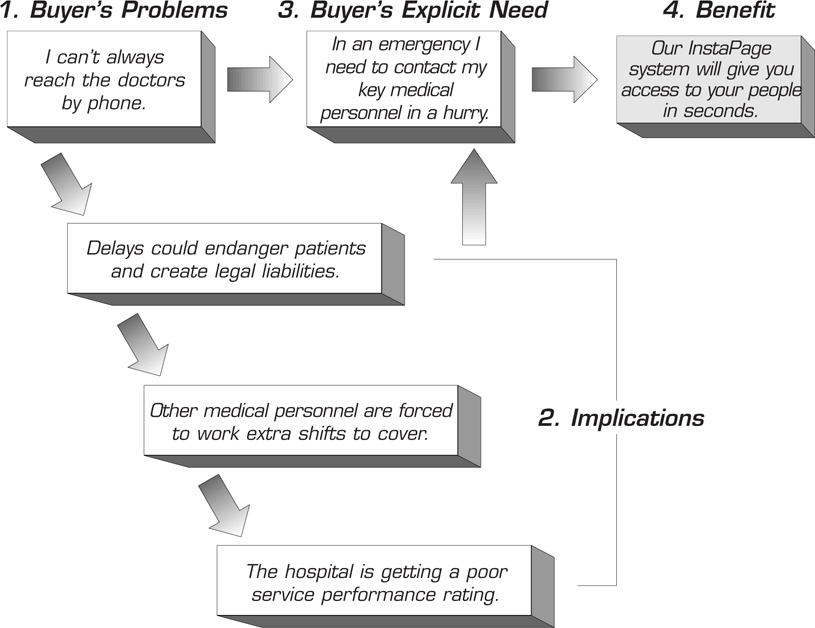
Example:
Now you try it, using an example of your own.
Beyond the Basics—Demonstrating Capability
More on Handling Objections
Preventing objections is always preferable to handling objections. Some interesting findings have emerged from our research:
![]() Objections are not buying signals—sellers who receive more objections do not experience more sales success.
Objections are not buying signals—sellers who receive more objections do not experience more sales success.
![]() A majority of objections are created by the seller.
A majority of objections are created by the seller.
![]() Many objections occur because the seller offers solutions too soon.
Many objections occur because the seller offers solutions too soon.
Even when you use the SPIN® questions and develop buyer needs, some objections will occur. So it’s essential to have objection-handling skills. But be careful not to get trapped into giving objection handling more prominence than objection prevention.
Why do objections occur? Often they occur because of factors beyond your control, such as buyer doubt, resistance to change, competition, inherently small buyer needs, or needs you can’t meet with your product or service. For example, your buyer needs double-sided copying and your copiers don’t provide that.
Objections fall into two overall categories:
1. Value Objections—where the buyer raises doubts about the value, worth, or usefulness of the solution you’re selling, e.g., “That’s not much use to me,” “It’s too expensive,” “I don’t need it.” (You’ve already worked with value objections in this chapter. Use Implication and Need-payoff Questions to develop the buyer’s need and to build the desire for a solution. The key is to move the buyer’s need from Implied to Explicit.)
2. Capability Objections—where the buyer sees the value of solving the problem but raises doubts about the capability, capacity, or genuineness of the seller, the seller’s organization, or the product or service being sold, e.g., “I don’t think you understand our business,” “I’m sure it’s not as easy as you claim.”
There are two kinds of capability objections. Each requires a different strategy:
Capability/Can’t Objections—These kinds of objections occur when you don’t have a capability to meet a need that is of high value to the prospect.
Capability/Can Objections—These objections occur when you do have a capability but the buyer doesn’t perceive that you have it.
Strategies for Handling Capability/Can’t Objections
The strategy for handling Capability/Can’t Objections has two steps:
1. Acknowledge that you can’t meet the need.
2. Increase the value of the capability you do have. Reemphasize the importance of the needs you can meet by using Need-payoff Questions and Benefit statements.
The aim of this strategy is movement. However, since you can’t increase the buyer’s perception of your capability, you have to increase the value of other needs for which you do have the capability.
Example
The seller, a senior manager in an accounting firm, is meeting with Jack Beck, president of a trucking company:
BUYER Believe me, I understand your timetable, but I need to move faster than that.
SELLER Hmmm … Well, as you know, I don’t think we can have that finalized in much less time than we talked about. But let’s step back and see where we are. [Acknowledges that he doesn’t have the particular capability.]
BUYER Well … okay.
SELLER Jack, I can see how moving that ahead a week or two would help. But I guess you have to consider the trade-offs—because you also said personalized service was important, and agreed that we’re best able to provide it.
BUYER Yeah … You’re right about the personalized service, but I’m concerned because getting a head start on next year’s work could turn out to be crucial.
SELLER Yes, I understand … but could your need for personalized service prove to be important next year? For example, you’ve mentioned that you’re planning an analysis of your cash management system. Isn’t that a case where our help would be extremely important? [Increases the value of the capability you do have.]
BUYER True … we will need a lot of special help on that one.
SELLER So, the personalized service we’ve talked about might be important in a number of areas? [Increases the value of the capability you do have.]
BUYER No question … In fact, as we talk, more things are coming to mind. Let’s see if there is some way we can look at this and try to….
Here the seller is able to emphasize the importance of the existing capability (personalized service) by asking Need-payoff Questions, which helps the buyer to see its value.
Strategies for Handling Capability/Can Objections
There are three steps in the strategy for handling Capability/Can Objections:
1. Acknowledge the legitimacy of the buyer’s concern. Show the buyer that you understand it’s a reasonable concern.
2. Demonstrate your capability. Explain how you can provide the capability.
3. Show proof, where necessary. Provide a source(s) of proof that genuinely supports that you are able to meet the need.
Example
The seller is a bank officer meeting with the buyer, who is president of a small company that is about to enter the international market.
BUYER Regarding the foreign exchange area, it seems to me I’d be better off going with one of the money center banks.
SELLER Uh-huh.
BUYER Since the money center banks do have experience in that area, I suspect that they’ll be able to provide us with better foreign exchange rates.
SELLER Well, you certainly do want the best rates [acknowledges the legitimacy of the objection], but today you don’t have to be a money center to be competitive in the foreign exchange market.
BUYER Oh … Why’s that?
SELLER Well, it’s a matter of having the right kind of information service. We’re in direct contact with the European market. So we’re always aware of the best prevailing rates. [Demonstrates capability of the seller’s organization.]
BUYER Well, I think I understand that, but this is our first marketing effort in Europe, and we do need to get off on the right foot.
SELLER Uh-huh. Well, what I think we should do is have you talk with Bob Townsend at Borax. He just addressed this same issue. I’ll also send you a publication just put out by The Wall Street Journal, which I think will be of some help. [Shows proof by offering other supporting sources.]
BUYER Okay … Sounds good.
Capability/Can Objections are handled most effectively by using a simple straightforward strategy. The major error that occurs in handling this kind of objection is failing to acknowledge the legitimacy of the buyer’s concern.
Launching New Products or Services
One area of Demonstrating Capability that even the most experienced salespeople handle poorly is the introduction of new products or services.
We’ve studied many product and service launches and found that, when an offering is new, salespeople give three times as many Features and Advantages than they do when selling existing offerings. And their level of questioning falls off dramatically. Because they’re not asking questions, they tend to introduce new product solutions very early in the discussion, which, as we’ve seen, is not an effective way to sell.
Even worse, their enthusiasm for the new offering can make them product-centered instead of buyer-centered. As a result, they talk about the bells and whistles of the new product or service, instead of asking about the buyer’s needs. Then it becomes all too easy, especially if you were introduced to the product or service in terms of its Features and Advantages, to communicate about it with your buyers in the same way. Don’t let it happen to you!
The best strategy for launching new products or services consists of a consolidation of steps you practiced in Chapters 5, 8, and 9:
DEMONSTRATING CAPABILITY—SUMMARY CHECK
Answers are on the next page.
SUMMARY CHECK—ANSWERS
1. (a), (c), and (d) are true. Giving Features at the beginning of a sale is at best neutral, often raises price concerns, and can actually jeopardize the sale.
2. Only (c) is a Benefit.
(a) is not a Benefit because the need is assumed rather than expressed.
(b) is not a Benefit because the need for change is too broad and general to be linked to telephones. The need is not Explicit.
(c) is a Benefit because the seller links the product (a noise reduction facility) to an expressed and Explicit Need of the buyer.
(d) is definitely not a Benefit, even though some sellers try to convince buyers with statements like this.
3. None of these statements is a Benefit.
(a) is a Feature. Despite the tempting word only, the seller is simply giving data about the product.
(b) is a Feature. The seller is describing a characteristic of overhead value analysis.
(c) is an Advantage. This is a very difficult example. It may seem at first glance to be a Benefit, but the buyer’s need is only Implied, not Explicit. Although the buyer raised a problem about lack of space, the seller’s quick link to double-sided copying is unlikely to have a positive effect on the buyer, who may find it irrelevant. Statements like this should thus be treated as Advantages. It would be a Benefit if the buyer had first developed the need using a Need-payoff Question such as, “So would you find it useful to have a way to reduce your filing space?”
(d) is an Advantage. The Feature is May and the Advantage is avoiding crowds.
(e) is an Advantage. The Advantage of the bulk-purchase plan is the discount. Because no Explicit Need was expressed, there is no Benefit.
